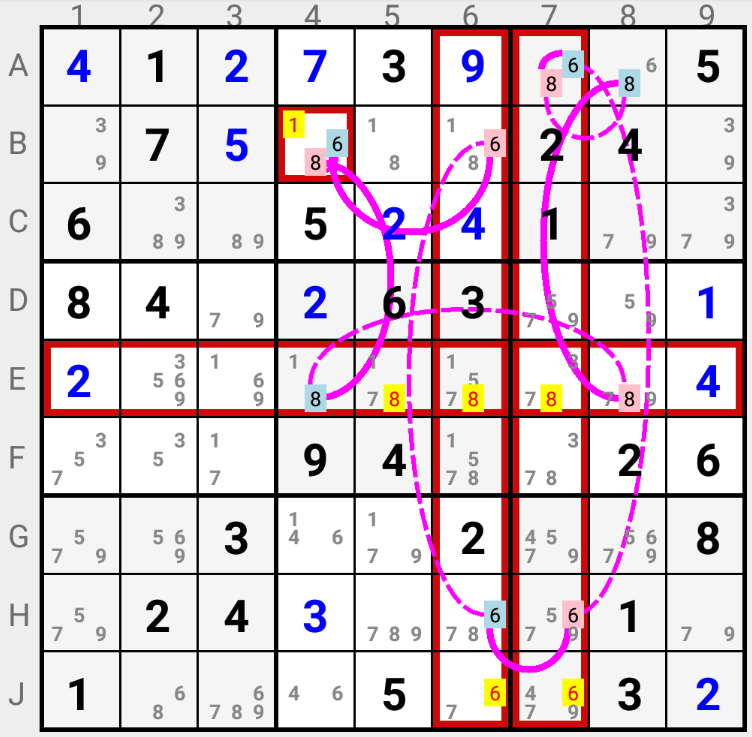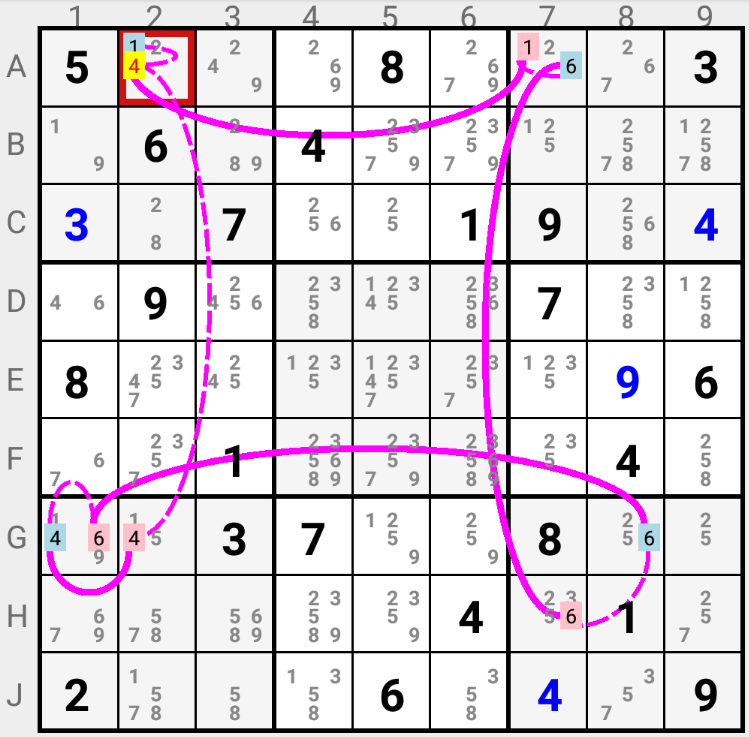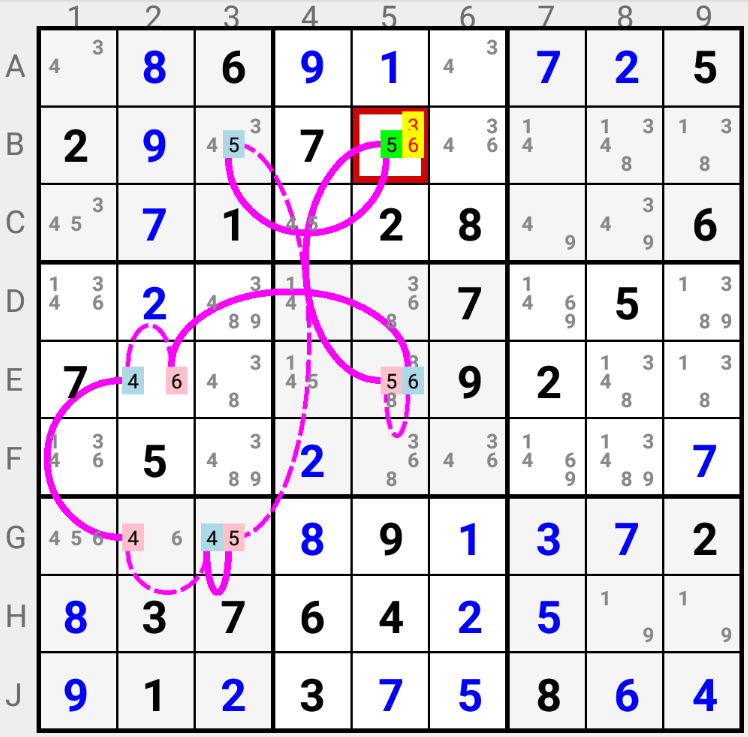Alternating Inference Chain
In the Alternating Inference Chain strategy we build loops by alternately chaining Strong Links (also see note at the bottom of this page) and Weak Links. Such a loop can be read in both direction; whatever the direction, a Strong Link remains a Strong Link and a Weak Link remains a Weak Link.
There are three kinds of Alternating Inference Chains :
- NICE LOOP : all along the loop Weak Links and Strong Links perfectly alternate
- DISCONTINUOUS LOOP WITH WEAK LINKS : we start from a Cell with a Weak Link and we close the loop on that Cell with another Weak Link; for the rest, the loop is "nice" (Weak Links and Strong Links perfectly alternate)
- DISCONTINUOUS LOOP WITH STRONG LINKS : we start from a Cell with a Strong Link and we close the loop on that Cell with another Strong Link; for the rest, the loop is also "nice".
If we can build a NICE LOOP, then each Weak Link starts on the end Cell of a Strong Link. Because of the definition of a Strong Link the candidate in the Cell at the end of the Strong Link must be the solution. As each Weak Link starts on a Cell that is the end of a Strong Link (whatever the direction used to read the loop), one of the Cells in the Weak Link has the candidate as its solution. Hence the candidate can not be the solution for any Cell that sees both ends of the Weak Link.

In the example if we start reading the Loop with candidate 8 "OFF" in B4 and follow the Strong Link to E4, then candidate 8 is the solution in E4, which eliminates all candidates 8 in Row "E" (and in Square "5").
If we read the Loop in the other direction, starting with candidate 8 "OFF" in A8 and follow the Strong Link to E8, then candidate 8 is the solution in E8, which eliminates all candidates 8 in Row "E" (and in Square "6").
In both cases candidate 8 must be the solution in either E4, or E8. As all other cells in Row "E" see E4 and E8, candidate 8 can not be the solution in any cell of Row "E" except in E4 and E8.
NB: a Weak Link can be built inside a Cell (see B4), just like a Strong Link.
When we build a DISCONTINUOUS LOOP WITH WEAK LINKS, the Cell where the discontinuity occurs simultaneously sees the starting Cell of a Strong Link and the ending Cell of a Strong Link (whatever the direction used to read the loop). Because the candidate in the ending Cell of a Strong Link must be the solution for that Cell, the Cell where the discontinuity occurs always "sees" a Cell where the candidate is the solution. Hence the candidate in that Cell can not be the solution for that Cell.

In the example if we start reading the Loop by following the Weak Link from A2 to G2 we eventually must follow the Strong Link from A7 to A2 which implies that candidate 1 is the solution in A2, hence eliminating candidate 4 in A2.
If we read the Loop in the other direction, starting with candidate 4 "ON" in A2 and following the Weak Link to candidate 1 "OFF" in A2 we eventually must follow the Strong Link from G1 to G2 which implies that candidate 4 is the solution in G2, hence eliminating candidate 4 in A2.
Whatever the direction used to read the Loop, candidate 4 can not be the solution in A2.
When we build a DISCONTINUOUS LOOP WITH STRONG LINKS, the Cell where the discontinuity occurs simultaneously is the starting Cell of a Strong Link and the ending Cell of another Strong Link (whatever the direction used to read the loop). Because the candidate in the ending Cell of a Strong Link must be the solution for that Cell, the Cell where the discontinuity occurs must have the candidate as its solution.

In this example if we start reading the Loop by following the Strong Link from B5 to B3 we eventually must follow the Strong Link from E5 to B5 which implies that candidate 5 is the solution in B5.
If we read the Loop in the other direction by following the Strong Link from B5 to E5 we eventually must follow the Strong Link from B3 to B5 which implies that candidate 5 is the solution in B5.
Whatever the direction used to read the Loop, candidate 5 must be the solution in B5.
NB: more formally, a Strong Link is the relationship that exists between two Cells in a region (Row, Column or Square) when these two Cells are the only Cells in that region
that contain a particular candidate: if the candidate is not the solution for the first Cell, then it must be the solution for the second Cell, and vice-versa.
However, in the Chaining Strategies, we consider Strong Links as links going from a Cell or a group of Cells
where we assert the candidate is not the solution (we say the candidate is in the "OFF" state)
to a Cell or a group of Cells where it then must be the solution (we say the candidate is in the "ON" state).
If we consider a Bi-Value Cell, asserting that one of its candidates is not the solution implies that the other candidate must be the solution.
Hence there also exists a Strong Link between the two candidates of a "Bi-Value" Cell.
A Weak Link as a link going from a Cell/group of Cells where the candidate is "ON" to a Cell/group of Cells where it is "OFF".
You can practice this strategy by installing the SudokuCoach application on your Android™ device.
